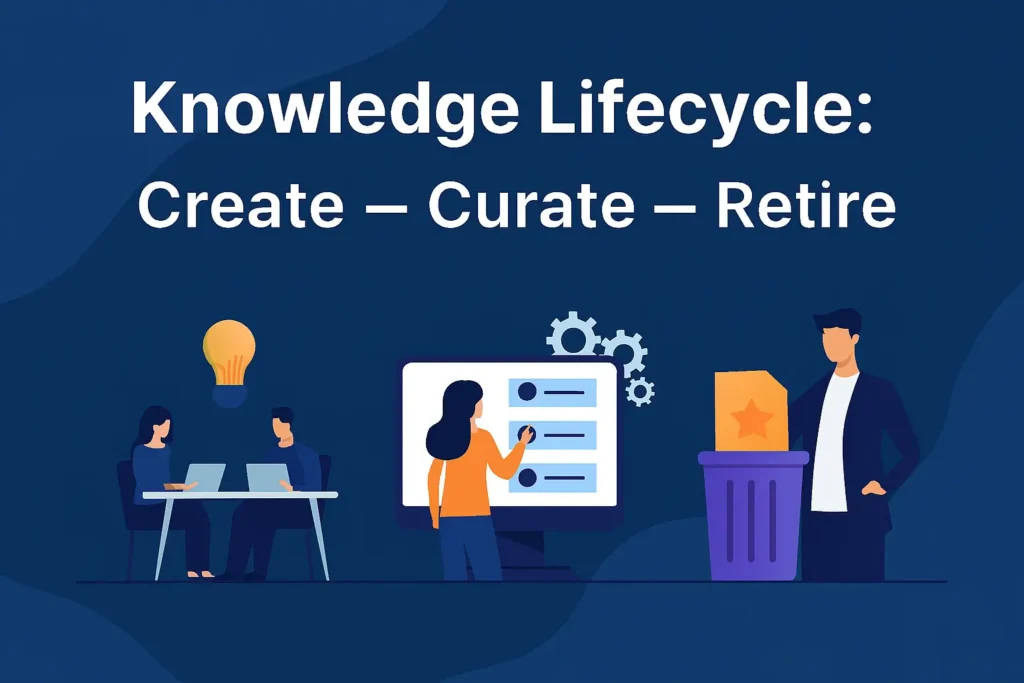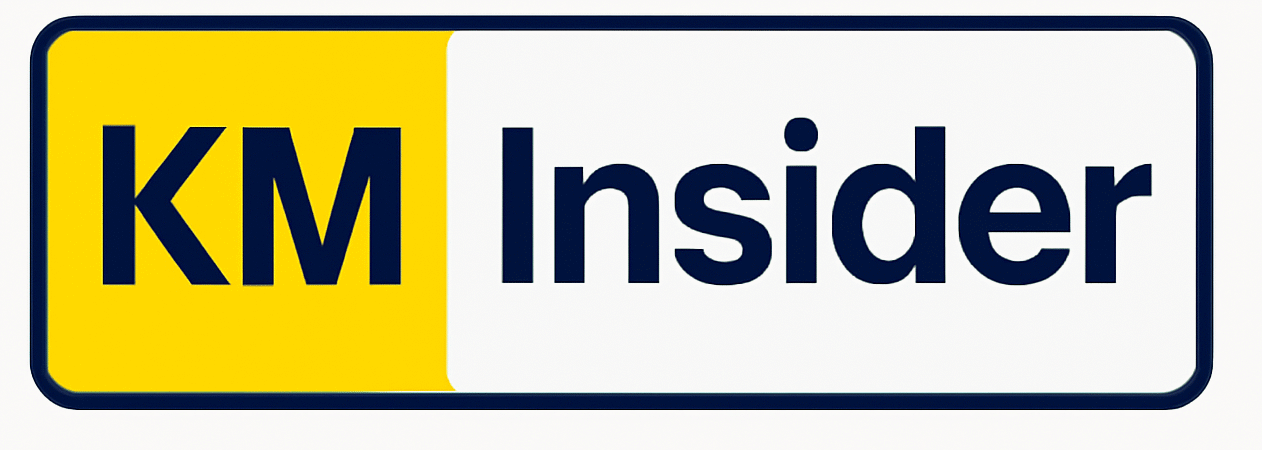Every organization creates knowledge every single day in conversations, project plans, incident reports, and customer interactions. Yet only a fraction of that knowledge becomes truly useful. The rest stays scattered, outdated, or forgotten. The reason isn’t lack of tools or talent. It’s the absence of a deliberate knowledge lifecycle — a system that governs how knowledge is created, curated, and retired over time.
In mature knowledge-driven organizations, information doesn’t live forever. It evolves, matures, and eventually makes room for new insight. That evolution is what separates a static content repository from a dynamic knowledge management ecosystem.
Let’s explore what the knowledge lifecycle really means, why it’s essential, and how organizations can operationalize the “Create–Curate–Retire” model to ensure their collective intelligence stays fresh, reliable, and valuable.

Understanding the Knowledge Lifecycle
The knowledge lifecycle is the continuous process through which knowledge is generated, validated, shared, maintained, and eventually removed or archived when it no longer serves current needs. It mirrors natural life cycles — creation, growth, maturity, and decline — except its purpose is to sustain organizational learning and decision-making quality.
Without a managed lifecycle, organizations experience what many knowledge managers call “knowledge decay.” Old documents remain accessible but misleading, duplicate materials proliferate, and employees spend more time searching than solving. Studies suggest that employees waste up to 30% of their workweek searching for or recreating information that already exists. The lifecycle model is designed to stop that leak.
A strong knowledge lifecycle achieves three core goals:
- Capture new insights quickly and effectively.
- Keep existing knowledge accurate, relevant, and discoverable.
- Retire obsolete content responsibly, ensuring only trustworthy information circulates.
Phase 1: Create — Turning Experience into Assets
The lifecycle begins with knowledge creation — the moment insights, learnings, or innovations are captured in a structured form. This is where tacit knowledge (what people know) becomes explicit knowledge (what others can use).
Sources of Knowledge Creation
Knowledge is born in multiple ways:
- Project documentation: lessons learned, retrospectives, and success stories.
- Customer interactions: feedback loops, support tickets, and escalation analysis.
- Innovation and R&D: prototypes, research notes, and experimentation logs.
- Operational execution: process updates, automation scripts, and workflow improvements.
But capturing information isn’t enough. The real value of the creation stage lies in how it’s documented. High-performing organizations follow what IBM once called the “context + content” rule — meaning every piece of captured knowledge must include why something was done, not just what was done.
Best Practices for Knowledge Creation
- Embed capture in the workflow. Instead of treating documentation as an afterthought, integrate it into daily processes. For example, include a “knowledge note” field in project closure templates or CRM records.
- Encourage storytelling. Capture the narrative behind the outcome — challenges, decisions, and lessons. Stories turn abstract insights into relatable guidance.
- Use templates for structure. Templates maintain consistency across teams, reducing ambiguity and making search easier later.
- Validate early. New knowledge should be peer-reviewed or manager-approved before publishing. This prevents low-quality data from polluting the repository.
Knowledge creation thrives in cultures that value learning over perfection. The goal isn’t to write flawless documentation; it’s to ensure that no valuable learning disappears in silence.
Phase 2: Curate — Keeping Knowledge Useful
If creation is about adding knowledge, curation is about improving it. It’s the process of verifying, updating, organizing, and enriching knowledge assets so they remain trustworthy and easy to find.
In many organizations, this is where knowledge systems fail. Teams capture data enthusiastically for a few months, but without curation, repositories become cluttered and irrelevant. The result: employees stop trusting the knowledge base and when trust dies, so does reuse.
The Role of Curation in the Knowledge Lifecycle
Curation transforms information into a living knowledge ecosystem. It involves:
- Reviewing content for accuracy and relevance.
- Eliminating duplicates or merging overlapping entries.
- Adding metadata, taxonomy tags, and cross-links.
- Ensuring consistent language and structure.
- Promoting high-value assets to the forefront (FAQs, expert articles, etc.).
Curation is not a one-time task — it’s a governance function. In fact, the best KM teams treat curators as “knowledge editors,” much like a newsroom has editors who verify facts before publication.
Practical Curation Techniques
- Adopt review cycles. Every piece of knowledge should have an expiry or review date (e.g., 12–18 months). Automated reminders can help authors refresh or retire outdated content.
- Leverage analytics. Monitor usage metrics — if a document hasn’t been viewed or updated in a year, investigate why. Either improve it or retire it.
- Apply taxonomy consistently. Use standardized tags and categories so people can find what they need through intuitive search paths.
- Encourage expert stewardship. Assign domain experts as “knowledge owners” responsible for reviewing content in their field.
- Link related assets. Context improves comprehension. Interlinking related content helps users see the bigger picture rather than isolated fragments.
Curation is the heart of the knowledge lifecycle because it keeps the ecosystem alive. Creation produces knowledge; curation ensures it stays relevant.
Phase 3: Retire — Knowing When to Let Go
Every piece of knowledge has an expiration date. Processes evolve, technologies change, and organizational priorities shift. Yet most companies are reluctant to delete old knowledge, fearing loss of history. The result is knowledge clutter — outdated content that hides useful material beneath layers of digital dust.
Why Knowledge Retirement Matters
Obsolete knowledge is not harmless; it’s dangerous. It can lead to:
- Incorrect decisions based on outdated data.
- Compliance risks when old regulatory versions persist online.
- User frustration due to irrelevant search results.
According to a Gartner survey, over 40% of enterprise knowledge bases contain outdated or redundant content — content that actively reduces system credibility. Retirement is not deletion for the sake of cleanup; it’s a quality assurance practice.
How to Retire Knowledge Responsibly
- Define clear retirement criteria. For instance, any content that hasn’t been used in 24 months, or is superseded by a new version, qualifies for retirement.
- Archive, don’t just delete. Move retired knowledge to an accessible but clearly labeled “archive zone.” This preserves institutional memory without polluting live systems.
- Communicate change. When knowledge is retired or replaced, notify stakeholders or teams that relied on it. Transparency builds trust.
- Track version history. Maintain version control so teams can trace when and why a document was retired.
- Reward maintenance. Recognize contributors who proactively clean or update content — this builds a culture of stewardship.
Retiring knowledge is like pruning a tree: it encourages new growth. Without it, the system becomes dense and unmanageable.
The Hidden Phase: Reuse — The Real Payoff
While “Create–Curate–Retire” is the formal lifecycle, the unspoken goal is reuse. The knowledge lifecycle only creates value when people actively use and apply stored knowledge in their work.
Organizations like NASA and Deloitte have shown that structured knowledge reuse can reduce project cycle times by 20–30% and improve innovation outcomes dramatically. The trick is to integrate knowledge access into daily workflows — through search bots, contextual recommendations, or embedded knowledge panels in tools employees already use.
If the lifecycle runs smoothly, reuse happens naturally. People trust the content because it’s fresh, findable, and verified.
Technology Enablers for the Knowledge Lifecycle
Technology alone doesn’t ensure a healthy lifecycle, but it makes the process scalable. Modern KM platforms now embed lifecycle intelligence into their design:
- Automated tagging and AI-driven metadata to classify new content accurately.
- Lifecycle workflows that flag outdated articles for review or retirement.
- Usage analytics dashboards showing top-used, unused, and at-risk knowledge.
- Smart notifications that remind authors to refresh or retire based on engagement trends.
- Integrated knowledge capture tools (such as Slack or Teams plug-ins) that simplify the creation process.
Platforms like ServiceNow Knowledge, Confluence, SharePoint Syntex, and Bloomfire have introduced lifecycle management modules that combine these functions. But tools are only as effective as the governance model that supports them.
Governance and Ownership Across the Lifecycle
A successful knowledge lifecycle requires defined roles and responsibilities:
- Authors/Contributors: Create and update knowledge content.
- Curators/Editors: Review, tag, and validate information for accuracy and readability.
- Owners/Stewards: Ensure ongoing relevance, manage review cycles, and approve retirements.
- KM Administrators: Oversee system integrity, analytics, and workflow automation.
- Executives/Sponsors: Provide strategic direction, funding, and visible support.
Together, these roles ensure that knowledge isn’t just collected — it’s continuously cared for.
A mature governance structure includes:
- Defined review intervals (e.g., 12 months).
- Escalation workflows for unreviewed or expired knowledge.
- Policies for archiving, deletion, and versioning.
- Regular health audits of the knowledge base.
This governance backbone ensures that the knowledge lifecycle is not dependent on individual initiative but embedded in organizational rhythm.
Culture: The Invisible Engine Behind the Lifecycle
Technology and governance can only go so far without culture. A knowledge-sharing culture is what keeps the lifecycle alive. When employees view knowledge as a collective asset rather than personal property, the system thrives.
Leaders play a critical role here. When they share lessons learned publicly, recognize good documentation, and celebrate retirements as much as creations, they reinforce the message that managing knowledge is everyone’s responsibility.
Cultural rituals — like “knowledge cleanup days” or “retirement sprints” — help normalize the process. Just as teams celebrate launches, they can celebrate responsible archival. It signals maturity.
The Payoff: An Adaptive, Intelligent Organization
A well-managed knowledge lifecycle transforms the organization into a continuously learning entity. It allows companies to adapt faster, make better decisions, and preserve institutional wisdom without carrying unnecessary weight.
The benefits are tangible:
- Reduced duplication of effort.
- Improved accuracy of decision-making.
- Faster onboarding and role transitions.
- Lower risk of compliance or operational errors.
- Stronger trust in the knowledge base.
Ultimately, a healthy lifecycle ensures that knowledge like any living system stays vibrant, relevant, and ready for use.
Closing Thoughts
The true measure of a knowledge management system isn’t how much content it holds, but how current, usable, and trusted that content is. The knowledge lifecycle — Create, Curate, Retire — provides the discipline to maintain that trust.
Creation brings ideas to life.
Curation keeps them sharp.
Retirement makes room for the next evolution.
Organizations that embrace this continuous cycle don’t just manage knowledge — they sustain intelligence. They build ecosystems that think, evolve, and improve long after individual contributors have moved on.
The companies winning in 2025 are not those that have the most data, but those that have mastered its life from creation to retirement and everything in between.
